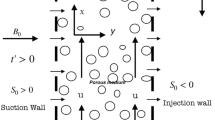Abstract
Based on the assumption of the creeping flow with small Reynolds number, a coupled model of bubble rising and mass transfer was established. Through numerical simulation, the velocity field inside and outside the bubble and the deformation of the bubble at different time under different voltage conditions were studied. The behavior characteristics of bubbles under different electric fields were compared and analyzed. The results show that the electric field force has an effect on the flow field and the shape of bubble rising. Under the action of voltage, the bubbles are elongated and deformed along the field strength direction. The electric stress on the bubble interface is the key factor of bubble deformation. With the electric field applied, the flow rate of liquid and the volume fraction of vapor near heat source increase. The degree of inconsistency increases with the improvement of electric field intensity. Electric field enhances convection and disturbance of fluid. The thermal efficiency of fluid near heat source improves. The process of bubble growth and detachment accelerates. The thermal resistance between the heat source and the fluid decreases, and the heat transfer efficiency increases. The research results can be guided for further studying the mechanism of electric field enhanced boiling heat transfer.









Similar content being viewed by others
Abbreviations
- a q :
-
Volume fraction of q-phase
- c p :
-
Specific heat capacity at constant pressure (J/kg·K)
- σ :
-
The conductivity of the working medium (S/m)
- E :
-
Electric field intensity (N/C)
- ε :
-
Dielectric constant (C2/(N m2))
- F e :
-
Dielectrophoresis force (N)
- \( F_{\text{V}} \) :
-
Volume force of the electric field (N)
- η :
-
Dynamic viscosity (N s/m2)
- λ :
-
Coefficient of thermal conductivity (W/(m k))
- P :
-
Pressure (Pa)
- ρ :
-
Density (kg/m3)
- r :
-
Radius (m)
- t :
-
Time (s)
- T:
-
Temperature (K)
- u :
-
Velocity of x-direction (m/s)
- μ :
-
Kinematic viscosity (Pa s)
- v :
-
Velocity of y-direction (m/s)
- v :
-
Volume (m3)
References
C S Zhu, D Han, L Feng and S Xu Chin. Phys. B 28 034701 (2019)
Y N Wang, D L Sun, A L Zhang and B Yu Numer. Heat Transfer Part A Appl. 71 1034(2017)
A L Zhang, Y N Wang, DL Sun, S Yu, B Yu and Y Li Numer. Heat Transfer Part B Fundam. 71 186 (2017)
C S Zhu, D Han and S Xu Chin. Phys. B 27 054215 (2018)
S M Korobeynikov, A G Ovsyannikov, A V Ridel and DA Medvedev J. Phys. Conf. Ser. 889 (2017)
D A Medvedev, A L Kupershtokh and A A Bukovets J. Phys. Conf. Ser. 899 (2017)
S Wu, R D Chippendale, P L Lewin, J Hemrle and L Kaufmann 35th Electrical Insulation Conference (Baltimore MA USA)p 11 (2017)
X Yang, Q Yang, Y Y Wu, T Zhang and P Wan J. Chem. Ind. Eng. Soc. China 64 3933 (2013)
Q Yang Master Thesis (Wuhan Institute of Technology, China) (2013)
T Zhang Master Thesis (Wuhan Institute of Technology, China) (2012)
Z G Dong, D L Cheng and R Y Li Chem. Ind. Eng. Progress 31 2420 (2012)
Y Peng, F Chen, Z Y Song and M Chen Chin. J. Chem. Eng. 16 178 (2008)
Y Peng, F Chen, Z Y Song and M Chen J. Tsinghua Univ. 48 294 (2008)
F Chen, Y Peng, Z Y Song and M Chen J. Tsinghua Univ. 47 722 (2007)
F Chen, Y Peng, Z Y Song and M Chen J. Chem. Ind. Eng. China 58 1706 (2007)
F Chen, Y Peng, Z Y Song and M Chen J. Eng. Thermoplys. 28 679 (2007)
F Chen, Y Peng, Y Z Song and M Chen J. Therm. Sci. Technol. 5 139 (2006)
S Tian Master Thesis (Dalian University of Technology, China) (2006)
C B Jiang, Y L Zhang and Z P Ding Computational Fluid dynamics (Beijing: China Electric Power Press) (2007)
R J Wang, K Zhang and G Wang Fluent Technical Basis and Application Example (Beijing: Tsinghua University Press) (2007)
F J Wang Computational Fluid Dynamics Analysis-CFD Software Principle and Application (Beijing: Tsinghua University Press) (2004)
Acknowledgements
The authors acknowledge the financial support provided by and the Fundamental Research Funds for the Central Universities (Grant No. 2018YZ02) and Yueqi Scholar Program for China University of Mining and Technology (Beijing).
Author information
Authors and Affiliations
Corresponding author
Additional information
Publisher's Note
Springer Nature remains neutral with regard to jurisdictional claims in published maps and institutional affiliations.
Rights and permissions
About this article
Cite this article
Gui, X., Song, X., Chen, L. et al. Research on dynamic behavior of bubble under the action of electric field. Indian J Phys 95, 2085–2093 (2021). https://doi.org/10.1007/s12648-020-01855-8
Received:
Accepted:
Published:
Issue Date:
DOI: https://doi.org/10.1007/s12648-020-01855-8




